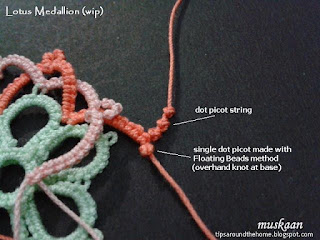This month I Love Tatting consisted of
working a pattern with at least 4 split rings. I kept tossing ideas in my head
– so many to choose from! Jean Lugert’s rose was a top contender – it’s on my
to-tat list. Or a pattern from Karen Bovard’s book? Then there were 2 of my own
designs – one prototype done a couple of years back, and another – a split ring
snowflake, no less – in my sketchbook. Also jostled with some braid ideas.
Finally fate intervened in multiple ways and I chose a pattern
mixing colour effects, techniques, and events. And kind of apt – 3 colours for
edition #3 of kocham frywolitke!
Adaptation of
Patty Dowden’s Mardi Gras
Snowflake
for I Love Tatting / Kocham frywolitke 3
Googled Mardi gras colours and loved the 3 that showed up!
Never tried this combo before, and in order to get the right shades, I chose
Anchor embroidery threads – 3 strands of each colour.
My initial thought was to wind 1 strand of each colour,
but discarded the idea.
And in order to use all 3 colours, with justice to each, I
planned on adding another round.
Substituted single shuttle split ring (SSSR) with the 2-shuttle split rings (SR) to comply with the challenge. Incidentally, SR is a composite ring while SSSR is a true ring.
The path wasn’t easy! Here is my 1st attempt. Something was wrong, I knew, but it took me a long time to figure it out.
Decided to start afresh and made the very same mistake at
the very same spot again!!!!
This time I unraveled and re-tatted. Kept a close eye thenceforth ;-P
This time I unraveled and re-tatted. Kept a close eye thenceforth ;-P
This is how the original pattern would look. It measures
6 cms.
One of the advantages of split rings is that one gets to play with colours in interesting ways.
One of the advantages of split rings is that one gets to play with colours in interesting ways.
The additional round is worked with 2 shuttles because of the thrown ring. But one can work the round with ball and shuttle by making it a mock ring.
Stitch count for this round is notated in the picture, but it can be changed to suit your preference and tension.
There are a couple of mistakes here but I’m still happy with the outcome. The purple chains create lovely petal outlines around the center (as do the yellow halves). And if we increase the stitches, the ‘petals’ will overlap!
I hope you give this a try some time - with SSSRs or SRs. Either way, it's a beautiful design.
happy tatting always J

















































